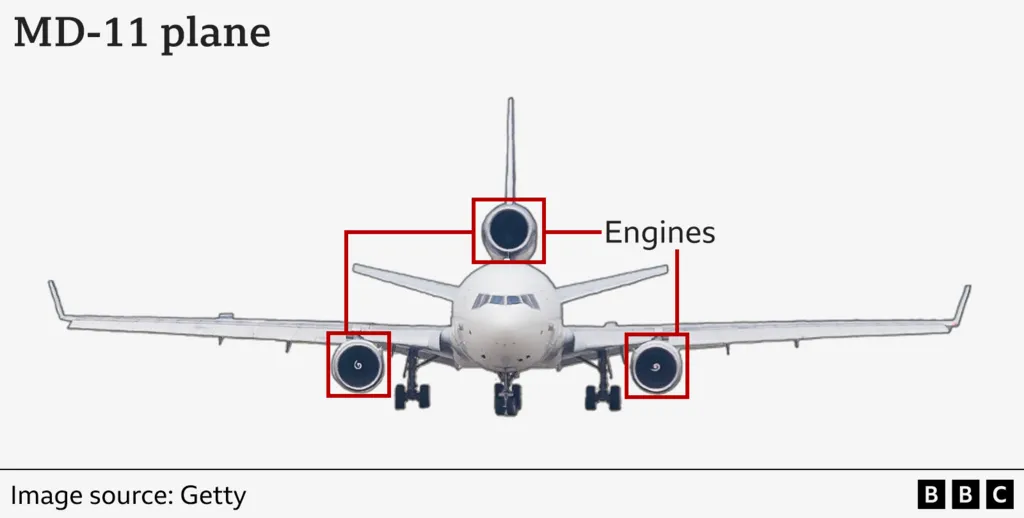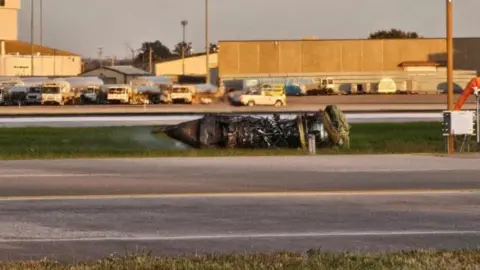World News
How Kentucky UPS plane crash unfolded and what could have caused it

At least nine people have died and 11 left injured after a UPS cargo plane crashed while taking off from an international airport in Louisville, Kentucky, on Tuesday evening.
Aviation experts who spoke to BBC Verify believe the plane crashed after one engine failed and another appeared to be damaged during take-off.
It is unclear what caused the plane to crash, prompting a massive fireball to erupt after it failed to take-off from the runway. Footage showed fire had already engulfed one wing of the aircraft while it was attempting to take off, which may have spread through the plane and caused the explosion, or the jet could have caught fire after colliding with an object on the ground.
What is apparent is that the 38,000 gallons (144,000 litres) of fuel on board the MD-11 jet needed for the flight likely escalated the blaze, which quickly spread to several buildings beyond the runway and burned for hours.
BBC Verify has been analysing footage that emerged overnight to piece together how the crash unfolded.
How did it start?
UPS uses Louisville Muhammad Ali International Airport as a distribution hub for its global operations and its Flight 2976 was at the start of a 4,300 mile journey to Honolulu in Hawaii when the cargo plane attempted to take off.
Data from tracking website FlightRadar24 shows the plane began to taxi along the 17R runway at around 17:15 local time (22:15 GMT) and managed to reach a top speed of 214mph (344km/h).
But verified footage shows that by the time the plane reached this speed a fire had completely engulfed its left wing and the aircraft struggled to climb away from the runway before the explosion.
Officials issued a shelter-in-place order to local residents and scrambled hundreds of firefighters to the scene.
Governor Andy Beshear confirmed details seen in CCTV footage that shows the aircraft flying just metres off the ground before a bright flash engulfed the plane. It is then seen slamming into the ground as a huge fireball erupts around it about a minute into its journey.
A verified clip taken by a motorists on a nearby highway showed the flames erupting into the skyline while later videos showed smoke billowing from the scene.
Aerial images broadcast by local media showed debris showering the runway and landing on the roofs of at least two local businesses.
What could have caused the crash?
Air traffic control communications reviewed by BBC Verify are largely garbled and full of interference so no meaningful conversation can be heard about the crash as it unfolded.
But analysts who spoke to BBC Verify suggested that a dramatic failure of two of the engines may have been responsible for the disaster.
The MD-11 transport plane uses three engines. Two are mounted under the wings, and a third is built into the tail at the base of the vertical stabilizer.

Footage confirmed by BBC Verify showed a blaze engulfing the left wing of the plane, which then tilted to the left as it attempted to gain lift and take-off.
Two experts independently suggested the left engine may have detached from the plane after suffering from a mechanical or structural failure.
Separate images taken after the crash showed a charred engine sitting on the grass next to the runway at Louisville International Airport.
Terry Tozer, a retired airline pilot and aviation safety expert, told BBC Verify that it was “almost unheard of” for an engine to detach in flight.

He referenced the 1979 American Airlines Flight 191 disaster, in which 273 people were killed after the plane’s engine detached as it took off at O’Hare International Airport in Chicago. Parts of the engine had been damaged when it was replaced on the plane, but Mr Tozer said it was too early to say whether a similar fault caused the engine to detach on the MD-11.
Mr Tozer said the cargo plane would have been able to fly with just two engines but the damage caused by the fire on the left wing was likely so great it caused the plane’s engine built into the tail to lose thrust.
“With such a catastrophic event we cannot know what other damage was done when the engine came adrift,” he said.
Marco Chan, a senior lecturer in aviation operations at Buckinghamshire New University, said the footage appeared to show the third engine had been damaged because it expelled a burst of smoke. The damage could have happened while it was pelted with debris from the fire and the engine detaching.
“The upper engine that expelled a puff of smoke appears to wind down almost immediately afterwards,” Mr Chan said. “That left only the right engine producing thrust, creating a severe power imbalance and leaving the aircraft unable to gain height.
“Losing two engines during take-off leaves the aircraft with only a third of its power and little chance of maintaining flight, especially at maximum take-off weight,” Mr Chan added.
Why did the crash cause such damage?
Footage from the aftermath of the crash showed a scene of complete chaos with multiple fires blazing across a large swathe of the site and smoke billowing into the sky.
The plane, which was 34 years old and had been used as a passenger plane until 2006, had already completed one return journey from Louisville on Tuesday to Baltimore in Maryland.
It has not been confirmed what cargo was on board the flight bound for Hawaii, though officials said the plane was not carrying anything that would create a heightened risk of contamination.
“This was a long-haul cargo flight from Louisville to Honolulu, so the MD-11 was carrying a lot of jet fuel,” Mr Chan said. “That heavy fuel load not only reduced performance but also explains the large fireball seen after the crash.”
Officials told reporters that the aircraft was carrying 38,000 gallons (144,000 litres) of fuel for the long journey when it crashed. The blaze was likely amplified on the ground because the aircraft slammed into a fuel recycling business next to the airport.
Mr Chan said investigators will now focus on how the initial fire began, and “whether debris struck the centre engine, and whether earlier maintenance on the left engine played a role”. He added: “Weather conditions were calm and clear, so environmental factors are unlikely.”
The National Transportation Safety Board (NSTB) has sent a team to the site and will now lead the investigation into the causes of the crash, though this can take up to two years to complete.
Additional reporting by Emma Pengelly, Kayleen Devlin and Paul Brown.
World News
Canada’s Carney welcomes MP who defected to the Liberals

A Conservative MP’s decision to cross the floor and join the Liberal party is “exceptionally valuable”, Canadian Prime Minister Mark Carney said on Wednesday, as he looks ahead to passing his first federal budget.
Chris d’Entremont from Nova Scotia defected to the Liberals on Tuesday shortly after Carney put forward his fiscal plan, inching the Liberal government closer to a majority.
Speaking to reporters on Wednesday, d’Entremont said he left because he no longer felt represented by Conservative opposition leader Pierre Poilievre.
Poilievre and his party have criticised Carney’s budget as doing little to address the cost of living while ballooning Canada’s deficit.
In a statement, the Conservative party accused d’Entremont of breaking his promises to the Canadians who elected him, and of defecting due to “personal grievances” with the party.
Nova Scotia’s d’Entremont resignation sent shockwaves through Ottawa on budget night.
In announcing his decision to leave, d’Entremont said he supported the Liberal budget and that it “hits the priorities” he has heard from people in his constituency.
“I came to a clear conclusion: there is a better path forward for our country,” he said.
At a news conference on Wednesday, he criticised Conservative leader Poilievre for what he said is his “negative” style of politics.
The MP won his riding narrowly last April in the riding of Acadie-Annapolis, coming ahead of the Liberal candidate by just one percentage point.
His decision to defect comes ahead of a scheduled leadership review for Poilievre in January and amid wider criticisms that his combative style of politics contributed to the Conservatives’ election loss earlier this year.
It also pushes Carney’s Liberals closer to a majority, as the prime minister looks to pass his government’s first budget through parliament. Failure to do so could risk another election.
On Wednesday, Carney appealed for more allies. “We’ll speak to anyone publicly or otherwise who can support us,” he said.
Carney later walked with the new Liberal MP into his first national caucus meeting, where they were greeted with applause.
A vote on the budget is expected to be held mid-November.
Carney’s government has called the fiscal plan as an “investment budget” meant to attract capital to Canada and shield it from the impact of US tariffs imposed by President Donald Trump.
It increases Canada’s deficit to C$78bn ($55.3bn; £42.47bn), the second largest in history, but also includes cuts like slashing the size of the federal workforce by 10% in the coming years.
The Conservatives and the Quebec sovereigntist party the Bloc Québécois have both indicated they will oppose it.
“This costly budget forces Canadians to spend more on debt interest than on healthcare transfers,” said Poilievre in the House of Commons on Tuesday evening.
The left-leaning New Democratic Party’s interim leader Don Davies said they still want time to study the budget before they decide. The party holds seven seats.
World News
Wife of abducted Malaysian pastor wins landmark lawsuit against state

The wife of a Malaysian pastor abducted eight years ago has won a lawsuit against the police and the government, in a landmark case that has gripped the nation.
Raymond Koh was pulled out of his car by masked men in a suburb of the capital Kuala Lumpur in 2017. His whereabouts remain unknown – his family has long maintained he was taken by police.
On Wednesday, the high court ruled he had been forcibly disappeared, with the judge holding the government and police responsible for his abduction. It is Malaysia’s first such judgement.
The court also ruled that the state must pay more than 31m ringgit (£5.7m; $7.4m) to Mr Koh’s family, the largest sum for damages in Malaysian legal history.
In an emotional speech following the decision, his wife Susanna Liew told reporters: “We are overjoyed and thankful to God that we have a fair and honest judgement.
“Though this will not bring Pastor Raymond back, it is somewhat a vindication and closure for the family,” she said.
“We dedicate this struggle and judgement to Pastor Raymond Koh, a man of compassion and courage, and to all victims of enforced disappearances.”
The disappearance of Mr Koh, along with the abduction of activist Amri Che Mat, has long intrigued Malaysia.
Both cases took place within months of each other between the end of 2016 and early 2017, and led to heated public speculation.
Mr Koh’s case, in particular, dominated the headlines because his abduction took place in broad daylight and had been captured on a CCTV camera, and was witnessed by passers-by.
Both families had insisted that the men had been taken by the police, which the police consistently denied.
The men’s disappearances prompted two investigations, one conducted by Malaysia’s human rights commission, and another by the government.
Both investigations eventually concluded that the men had likely been abducted by the elite Special Branch of the police as they were perceived as threats to mainstream Islam in Muslim-majority Malaysia.
The government report – which was classified as secret until the families sued for access – said that “rogue cops” were responsible for the abductions, and the official who led the operation had “extreme views” against Christians and Shia Muslims.
Mr Koh had been targeted because he was suspected of proselytising to Muslims, which his family has denied. Apostasy is illegal in Malaysia.
Amri Che Mat had come under suspicion as he is a Shia Muslim. Malaysia practises a moderate form of Sunni Islam.
The wives of Raymond Koh and Amri Che Mat separately sued the state for damages and to force the authorities to reveal their husbands’ whereabouts.

On Wednesday, the high court ruled that police officials, the Royal Malaysian Police, and the Malaysian government were liable for the abduction of Mr Koh.
Besides awarding several million ringgit to Ms Liew for emotional distress, the judge ruled that 10,000 ringgit (£1,830; $2,385) in general damages be paid for each day of Mr Koh’s disappearance, starting from when he was abducted and ending on the day his whereabouts are disclosed by the state.
The judge also ordered the state to reopen the investigation and ascertain Mr Koh’s whereabouts.
As of Wednesday, the rolling sum of the general damages works out to be more than 31.8 million ringgit. The final figure is expected to become the largest payout in Malaysian history, according to lawyers acting for Ms Liew.
The money will be deposited into a trust, to which Ms Liew and her children will likely be named as beneficiaries.
The high court judge also found the government and police liable for Amri Che Mat’s abduction. His wife Norhayati, who sued for lesser offences compared to Ms Liew’s lawsuit, was awarded about three million ringgit.
“The feeling of sadness remains because questions about Amri’s whereabouts, whether he is alive, dead, or in good health, are all still unanswered,” Norhayati told reporters.
“We sincerely hope that those responsible will be held accountable for what they have done.”
World News
At least 20 dead after magnitude-6.3 earthquake hits Afghanistan

At least 20 people have died after an earthquake struck northern Afghanistan, local authorities say, with the toll expected to rise as rescue efforts continue.
Hundreds have also been left injured, local officials told the BBC.
The earthquake struck near Mazar-e-Sharif, one of the country’s largest cities that is home to about 500,000 people, at around 01:00 local time on Monday, (20:30 GMT on Sunday).
It had a magnitude of 6.3 and a depth of 28km (17 miles), according to the US Geological Survey, and was marked at the orange alert level, which indicates “significant casualties” are likely.
More than 530 people have been injured, according to the Taliban government health ministry.
Provincial officials earlier told the BBC that casualties were likely to rise as rescue efforts continued.
Haji Zaid, a Taliban spokesman in Balkh province wrote earlier on X that “many people are injured” in the Sholgara district, south of Mazar-e- Sharif.
He said they had received “reports of minor injuries and superficial damages from all districts of the province”.
“Most of the injuries were caused by people falling from tall buildings,” he wrote.
Many of Mazar-e Sharif’s residents rushed to the streets when the quake struck, as they feared their houses would collapse, AFP news agency reported.
The quake led to a power outage across the country including in the capital city Kabul, after electricity lines from Uzbekistan and Tajikistan – major suppliers of power to Afghanistan – were damaged.
The Taliban spokesman in Balkh also posted a video on X appearing to show debris strewn across the ground at the Blue Mosque in Mazar-e-Sharif, revered by Shia Muslims.

The mosque, built in the 15th Century, is believed to house the tomb of the first Shia Imam, the son-in-law and cousin of Prophet Mohamad. It is now a site where pilgrims gather to pray and celebrate religious events.
Khalid Zadran, a Taliban spokesman for the police in Kabul, wrote on X that police are “closely monitoring the situation”.
Numerous fatalities were also reported in Samangan, a mountainous province near Mazar-e-Sharif, according to its spokesman.
The quake on Monday comes after a 6.0 magnitude earthquake struck Afghanistan’s mountainous eastern region in late August, killing more than 1,100 people.
That earthquake was especially deadly as the rural houses in the region were typically made of mud and timber. Residents were trapped when their houses collapsed during the quake.
Afghanistan is very prone to earthquakes because of its location on top of a number of fault lines where the Indian and Eurasian tectonic plates meet.
Poor communication networks and infrastructure – buildings there are not earthquake-resistant, for example – have often hampered rescue efforts following disasters like this.
-

 Europe News8 months ago
Europe News8 months agoChaos and unproven theories surround Tates’ release from Romania
-

 American News8 months ago
American News8 months agoTrump Expels Zelensky from the White House
-

 American News8 months ago
American News8 months agoTrump expands exemptions from Canada and Mexico tariffs
-

 American News8 months ago
American News8 months agoZelensky bruised but upbeat after diplomatic whirlwind
-

 Art & Culture8 months ago
Art & Culture8 months agoThe Indian film showing the bride’s ‘humiliation’ in arranged marriage
-

 Art & Culture8 months ago
Art & Culture8 months agoInternational Agriculture Exhibition held in Paris
-

 Politics8 months ago
Politics8 months agoUS cuts send South Africa’s HIV treatment ‘off a cliff’
-

 Politics8 months ago
Politics8 months agoWorst violence in Syria since Assad fall as dozens killed in clashes







